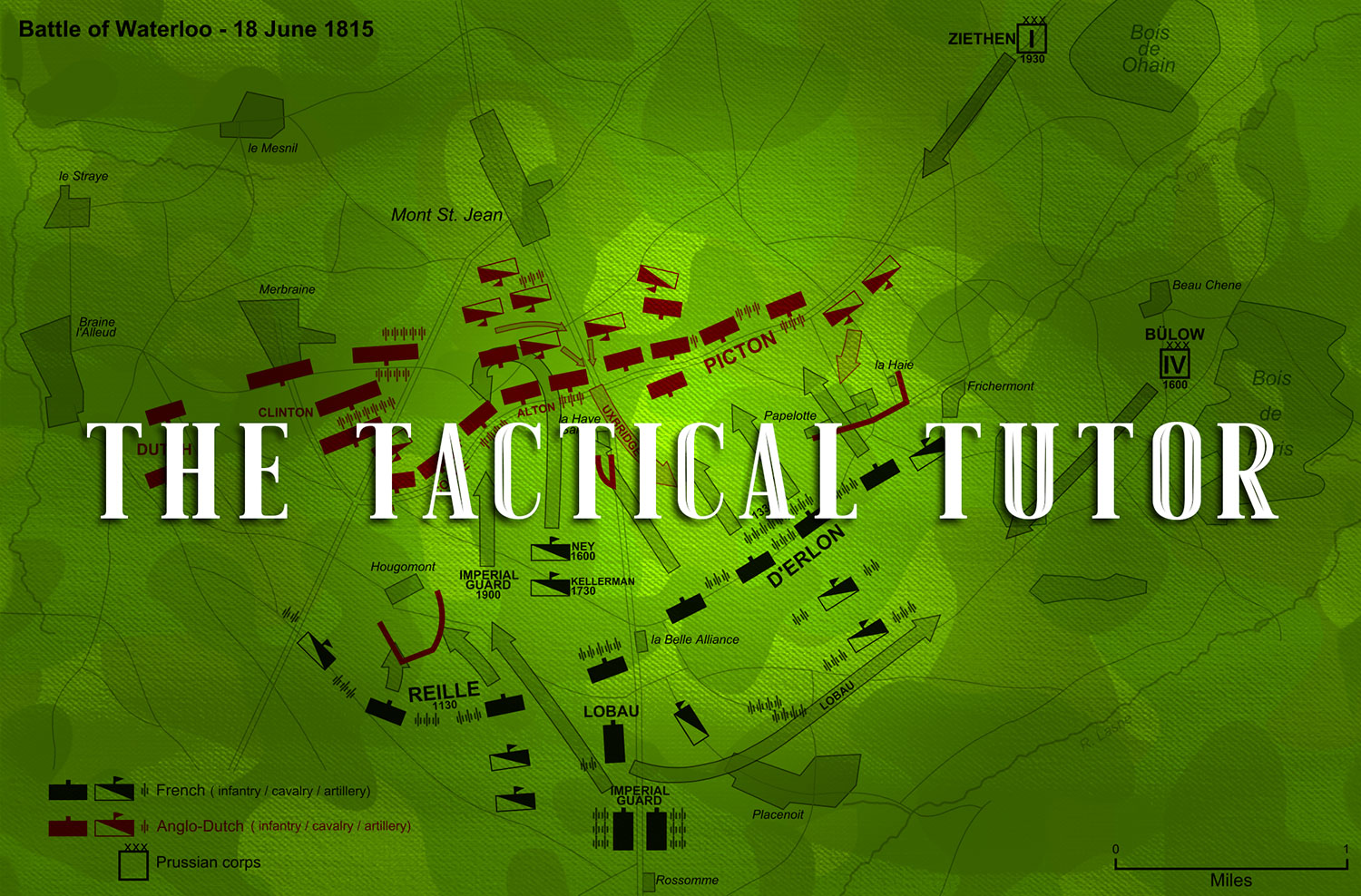
The Tactical Tutor Part 1
It Depends…
by Jay Arnold, The Veteran Wargamer
“Plans mean nothing. Planning is everything.”
— Dwight D. Eisenhower
Recently, Our ‘Enry wrote an article in Issue 93 of Wargames, Soldiers and Strategy in which he described a number of considerations appropriate to players of WWII games. I read the article with great interest and understanding. You see, in case you don’t know me, my name is Jay Arnold and I run a podcast called The Veteran Wargamer. Not only have I been wargaming for quite some time, I’m also a veteran of the US Army.
Henry touched on a number of concepts and tenets of ground warfare I teach to Officer Candidates on a regular basis. But, I noticed that while he gave a good overview of some important considerations, he left quite a bit of meat on the bone. So, to push the metaphor further, I’d like to roast the bones and stew them for a while to get all the juiciest bits to share with you. This article is the first in a series to help you bring real-world tactical lessons and concepts to the miniature battlefield.
Where to begin, then? It’s certainly a big topic. Indeed, leadership training in the US Army is based on opening the topic of battlefield success and increasing the levels of detail and layers of understanding as one climbs in rank. I’ll probably keep things relatively simple and easy to understand for neophyte and grognard alike. So, don’t expect to be a Jomini or Clausewitz when we’re done with this series, however long that takes. One last thing before we start, this genesis of this series is heavily influenced by an unpublished article my friend John Izbrand wrote and shared with me about 18 years ago. I owe him a significant debt for where my gaming has gone these past two decades.
We will begin with basic mission analysis. Even if you’re just lining up your plastic and metal miniatures on a table edge and throwing them against your opponent’s figures, you need to take a look at what constitutes the mission and a number of factors that influence it. The tool used by junior leaders to analyze their mission is the acronym METT-TC. It stands for:
- Mission
- Enemy
- Terrain
- Troops
- Time
- Civilians
Each one of these topics deserve their own article and we’ll get to them each in turn. For now, though, I’ll give a brief rundown of each so you may begin working on them in the ol’ noggin.
MISSION

The Mission is simply what you hope to achieve during the course of the game. This might be stated in a full mission or scenario brief. It might be as simple as “hey, let’s play king of the hill.” Either way, it’s what you need to do in order to “win” the game. This is the specified task. This is not the only thing you have to do on the battlefield, though. You have a number of actions to perform so that you can achieve your specified task. These are implied tasks. Intertwined with the specified and implied tasks are critical tasks. These are the specified and implied tasks that must be accomplished in order to fulfill the mission.
If you are using a full mission brief, your specified tasks should be stated in a mission statement. This states who, what, where, when and why. In a real five-paragraph operations order, the mission statement is actually the shortest paragraph. It might read like “B Company, 23rd Mechanized Infantry Battalion (who), attacks enemy forces (what), at Hill 235 (where), no later than 1200 hours, 18th MAY 2018 (when), in order to destroy enemy units (why).” I don’t want to get into a full discussion of the operation order at this time. The main thing I want you to focus on is the simplicity of the mission statement.
Even in a prepared scenario, you might not have a cut and dried mission statement. In the scenario, you may need to look really closely to pick out the what, where, when and why. “Who” is whatever force you are bringing to the table. It’s the “implied you.”
“What” might be a little more tricky. This is usually an action word. “Attack,” “Seize,” “Defend,” and “Delay” are classic examples. Hopefully your scenario’s writer has used similar words. The main thing to remember is determining the “What” is possibly the most important part of breaking down and planning for your mission.
This might be complicated by scenario systems that use victory points. Taking a look at how and why victory points are achieved will be crucial, especially if you are playing in a tournament. You will need to focus your efforts on scoring the most points you can while denying points to your opponent. Unfortunately, if you are playing in a tournament, you may find that scoring points might mean ignoring the scenario mission altogether. I would hope this is not the case, but we have to allow for it.
“Where” should be pretty obvious. We can imagine our tabletop subordinates have received a full mission brief and have made their way to the area of the battlefield represented on the table. In some cases, a particular part of the table might be where you need to focus your attention. A particular hill, or even a target area. Victory points might be won by capturing a table quadrant or a particular building. Additionally, points might be scored by denying your opponent the same. Of course, not all scenarios or games rest on victory points, but you get the picture.
“When” is an interesting concept in regard to a wargame. In general, we know what year or even day a historical scenario takes place. June 6th, 1944 is pretty well-known, as is July 1st through 3rd, 1863 for example. Rarely do we consider various times of day in our games. It’s as if all games take place at high noon on clear days. On the off-chance the scenario is written for night or hours of limited visibility, this will mean additional considerations for our miniature forces. More on this when we discuss Time, below.
The “Why” of a mission will most likely have more impact in a campaign setting than a one-off game. Aside from simply winning the game, we may need to gauge what motivates our men, women, cyborgs and orcs on the table to fight and maybe even have their hit points reduced to zero. My patron in this project, Henry, is of course writing a book on wargame campaigns. I am sure he will have much to say on this topic. One game that looks closely at mission motivation is Stargrunt II, by Jon Tuffley of Ground Zero Games. It’s part of a larger morale system that is quite subtle in its application and effects. It’s well worth a look, and being free to download, should be on every wargamer’s HDD.
The combined parts of the mission statement paint a picture of what the player should attempt to achieve during the course of the game, or at the very least how the player should start the game. One must of course keep in mind those implied tasks that help support and shape the game as it develops.
For example, if you are playing a micro-armor game set in Germany during the 1980s, you can probably count on having close air support available. But so can your opponent. In order to get your Motorized Rifle Battalion to meet and engage the enemy, you need to make sure they don’t get shot up by A-10s. You do this by keeping your anti-air assets near your maneuver elements. This is an implied task. Depending on the scenario, you may also need to cross a river. Establishing security and a base of fire on the near side of the river so you can bring up bridging units would be another implied task. The list goes on.
And this is the hard part. You can’t possibly cover all eventualities and plan for every potential implied task. You have to prioritize. What are the critical tasks you have identified? What can you safely set aside or even ignore and still achieve your primary mission/score the most victory points? These are important questions that you can and should ask as you prepare for your game. Take a moment before you play to think about the Mission and the stated and implied tasks (and which are critical) you need to accomplish.
ENEMY
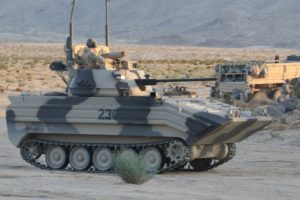
The Enemy is more than just the guy or gal you’re playing against. It’s all the figures, vehicles, dragons, magic spells, defensive works and everything else they bring to the game. You hopefully can have a moment to consider what they can do to hurt your forces. At the same time, identify their weaknesses.
What is the enemy’s disposition? That is, how many and what types of units does he have? Where are they? What is their status? Some games allow for hidden deployment of troops, or deployment under blinds, such as the TooFatLardies’ excellent WWII game I Ain’t Been Shot, Mum and its sci-fi analog, Quadrant 13. You need to be able to predict where the enemy most likely has placed units you can’t see. This is where a good look at the terrain is important, and we’ll discuss that more in a bit.
Possibly, most importantly, what is their likely mission? Sometimes, we as wargamers get lucky and might already know the enemy’s objectives! It certainly takes the guesswork out of the equation. Pretty handy, huh? This knowledge might affect how we understand our mission, especially if you’re playing the defender in a scenario.
Consider how the enemy forces interact with each other. Do they have special abilities that form synergies and magnify their power or effectiveness? XWing Miniatures from Fantasy Flight Games is an excellent example of a game that utilizes these synergies, often in ways not anticipated by the creators. Identification of those synergies can help you ID the enemy units you need to concentrate on neutralizing.
Even in a game that doesn’t rely heavily on special abilities, think about your enemy’s most dangerous course of action. What can they do that will hurt you the most? How can you defend against or neutralize it?
By the same token, however, consider their most likely course of action. This is where it gets fun if you play the same people on a regular basis. Is there a psychological lever you can use against them as a player to get them off their game? It might be a touch underhanded, but all is fair in love and war(games)! I’m not a professor of gaming ethics, but I’m not above playing the “metagame” as some folks call it. To some degree, the opportunity to pick and choose our forces with army lists and points systems is a metagame unto itself.
With that in mind, there are plenty of games with published army lists, codices and, it seems, special rules for every unit in it. You will be well served to acquire these lists and such if you’re so inclined. I am not advocating dumping hundreds of dollars on the books and apps the game publishers want you to buy and download. See if your buddy who plays orks will let you borrow his book while you lend him your book on the elves, for example. At a minimum, in a friendly game, I would expect my opponent to take a moment to explain what each unit is in mostly general terms, perhaps highlighting any special rules. I would expect to explain my force as well.
Something else to consider is how do the changing statuses of enemy units affect their performance? For example, in Fantasy Flight Games’ BattleLore, certain melee units actually become more dangerous as they take losses. Knowing this allows you to plan on neutralizing these types of units from a distance, rather than engaging them in close combat.
As Sun Tzu said, “know your enemy as you know yourself and the outcome of a thousand battles will never be in doubt.”
TERRAIN

I appreciate how Henry touched on Terrain in his article. Remember you most likely need to move, fight and survive on the battlefield in order to win. To do this, you need to take a look at the battlefield and consider the aspects of the following Terrain Analysis Tool – OKOCA. This mnemonic encompasses the main terrain considerations:
- Observation and fields of fire – what can my models see and engage with ranged weapons?
- Cover and concealment – what can I hide behind/in to keep from being observed or attacked?
- Obstacles – what will hinder my or my enemy’s movement?
- Key terrain – what terrain do I need to control to achieve or support my objective?
- Avenues of approach – where can I or my enemy move quickly?
If you can’t see the enemy, you can’t kill him. If the enemy can’t see you, he can’t kill you. Seems simple enough. Many of our game tables have wide open expanses that allow for all the line of sight a gamer could want. Whether or not this is realistic, or even plausible will depend heavily on the geographic area you’re trying to replicate. For example, the fields, forests and hedgerows of Northern Europe are decidedly more terrain-choked than the steppes of Russia or deserts of Iraq.
Placing your units so they can cover a significant portion of the table with either fire or observation is crucial. Note that observation can be just as crucial as fire when your troops are able to call in artillery or close air support. Terrain that blocks line of sight is typically heavy vegetation, man-made structures and natural terrain features such as hills and ridges.
In the case of modern, futuristic and fantasy games, there may be technology or magic that allows your troops and the enemy to see through blocking terrain. Keep these capabilities in mind when considering your deployment as well.
What blocks line of sight will provide cover and concealment in many cases. In fact, a wooded hill is the classic placement for a forward observer. Just to briefly clarify, cover provides protection from the effects of fire; concealment keeps the enemy from observing your forces.
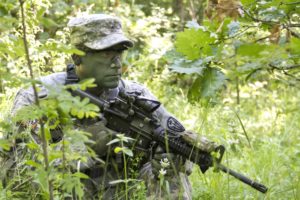
Often, there is not a distinction in our rules between the two. If there is a difference, it’s most usually “light cover” and “heavy cover,” each providing varying modifiers to hit or wound the target unit. Either way, so long as there is some advantage to being in a covered and/or concealed position, the rule suits our purposes. Again, there might be technology and magic that mitigates these benefits, as with observation.
Additionally, there is technology that can be used to enhance concealment or obscure observation. I am of course talking about smoke or other obscuring effects, such as casting a darkness spell in a fantasy game. Whether dispensed by specialized smoke generators, or from mortar rounds or grenades, or a wizard’s staff, smoke or other obscurants act as instant concealment. I hope your rules account for their use. Poison gas, as used in WWI, had obscuration effects, even if that wasn’t its primary purpose. If you have it in your list, use it! Conceal your advances by obscuring your objectives and reduce or eliminate the threat of machine guns, artillery and close air support.
We ignore the effects of obstacles at our peril. Rarely do we see much in the way of obstacles on our game tables, except as a bit of scatter terrain. This is a shame, as obstacles are a key component of the defense and can create interesting choices for defender and attacker alike.
Existing obstacles, such as rivers, impassable terrain features and built up areas provide opportunities to force the enemy to move in certain directions or through certain areas. These areas are easy to spot. By extension, they’re relatively easy to cover with observation and fire with a few well-placed teams. If your rules allow for it, throw down a few reinforcing obstacles while you’re at it. Minefields, wire obstacles and tank traps are a great way to force the enemy into your kill zones or break up his formations. Not only will he be forced to concentrate his forces in a relatively small area, but he’ll be vulnerable to artillery, close air support and your machine guns. As Murphy’s Laws of Combat state, “the easy way is always mined”.
With the above in mind, think about how you might have to react to and reduce the enemy’s obstacles. Where might he have hidden a machine gun or forward observer? Try to get units in position to observe those areas and fire on them to disrupt or destroy those assets.
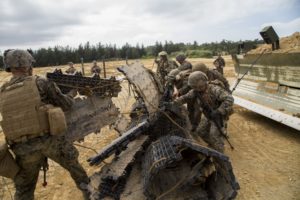
Key terrain is that which confers a marked advantage to the side the controls it. Notice that I didn’t say possesses it. If you can put fire on it, you can control it. You don’t necessarily have to put troops on it in order to control it. Beware identifying any and all high ground as key terrain, though. A hill that is relatively isolated on the table and doesn’t allow observation on any other terrain of worth isn’t key terrain. Meanwhile, the area surrounding a humble wooden bridge over an otherwise uncrossable river is indeed key terrain.
Getting where you need to go on the battlefield is the within the purview of avenues of approach. Usually, we mark out our roads and highways on the table with deliberation. But consider an open field with forest or rocky outcroppings on either side. The grassy field becomes an avenue of approach in this case. Many of our rules use open fields as the baseline movement value. Roads, paved or unpaved, might provide a slight advantage. As the defender, this is ground you need to cover with your machine guns and maybe a few mines, if you have them.
In the above examples, I’ve tried to demonstrate how the different terrain considerations interact with one another. Perhaps during your next game, you’ll spot how these interactions work to either aid or hinder the attacker and defender. And please, stop just laying out a bit of green cloth and calling it good! A river and some wooded areas instantly create a more challenging and engaging battlefield. Increase the terrain and you increase the challenge.
Another aspect of terrain that is not covered by OKOCA is weather. Too few of our scenarios have any mention of weather in them. Is it raining or did it rain recently? What about snow? Has a recent drought left the river shallow and easily forded? What about fog? Mobility and observation can both be affected greatly by the weather. Just ask the flower of French chivalry that was destroyed at Agincourt.
Of course, the weather might have negative effects on how our miniature forces fight. Did your archers’ bow strings get wet? What about the musketeers’ powder? Can you count on the dragons flying in all this damn fog? Plus, consider the terrible effects cold and wet have on the morale of your troops. Or perhaps thirst and sunburn are a greater danger to the little metal and plastic men.
TROOPS
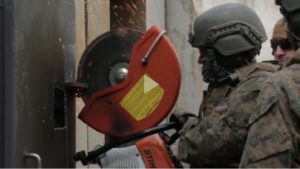
Of course, you need your own Troops to play the game! What can they do to achieve your objective? Sending your light infantry to take on an armored unit might not be the best way to use them, for example. Instead, use them for what they’re intended, seizing and defending that key terrain we mentioned earlier. Maybe some scouting is more their speed. More on scouting and reconnaissance in a later column.
Now, I would hope you would already be familiar with the capabilities of your own units. I’ll allow for convention games where you might be walking up to a table to try something completely new to you. Hopefully the person running the game can give you the broad strokes. Regardless, you have to know your own troops and their capabilities. What are they really good at? What are they really bad at? What are your own synergies?
Leveraging your strengths against your opponent’s weaknesses is critical. For example, if you can get your heavy cavalry to a place on the battlefield where he has left infantry in the open without the cover of his guns, you stand a pretty good chance of punching a hole in his line. Then they can gallop around in his rear area destroying his units in detail. This might be an extreme example, but there are plenty of historical precedents to guide us.
Here’s the flip side to a coin I mentioned above: What habits do you have while you’re playing that your opponent can exploit to their advantage? Will you place a freshly painted pet unit on the table and then mentally and emotionally collapse when they get absolutely wrecked? Something to consider!
TIME
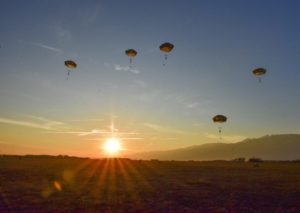
Time waits for no gamer! Whether you need to finish the game by a certain time to make it home for supper or the scenario calls for so many turns, it’s a huge influence on how you play a game. How long will it take to simply move enough forces where it needs to go to achieve your objective? Will you have time to set up a defense before the orks overtake your rearguard?
Of course, how far you can move your forces is complicated by rules that offer variable move distances or variable activation. A little bit of friction is what makes games fun, in my opinion. But I digress. A time crunch might cause you to take some risks you might not otherwise take.
As I mentioned earlier with weather, too few of our games consider the effects of nightfall or sunrise. Hours of reduced visibility are a classic time to conduct small-scale raids or an attack on a fixed position. Consider the advantage a force attacking from the east at sunrise has over defenders gazing into the sun looking for targets.
CIVILIANS

Very few games or scenarios make allowances for Civilians, but maybe they should. Will you get points deducted for harming non-combatants, or moving in certain areas? This topic deserves further discussion in a separate article. I notice that Gangs of Rome from Warbanner/Footsore uses the urban mob as a central part of the game. At time of writing, I haven’t played it yet, but I’ve got figures on the way! I am quite eager to see how the cives affect the game play. Force on Force/Ambush Alley also uses civilians if you want another example. In the interest of full disclosure, I am on the Ambush Alley playtest team.
Of course, there are significant social sensitivities surrounding civilians on the battlefield. That is as it should be. One of the appeals of playing games in North Africa during WWII is its relatively low impact on civilians. This is of course the case when compared to the fighting in Northern Europe or the Hell on Earth that was the Eastern Front.
I would caution that injecting civilians into games must be done carefully. Under current laws of warfare, they are a protected class.That being said, I’ve run games where if you got too close to built-up areas, the locals fired missiles at you!
As I draw this premiere entry in the series to a close, keep in mind what I said above as you begin planning for your next game. Keep thinking about it as you set up as well. While you’re at it, better keep thinking about it while the game is underway. No plan survives contact with the enemy, after all. Better to have these ideas constantly going for when you have to improvise, adapt and overcome.
That is all.
THIS POST IS EXCLUSIVE TO PATRONS FOR 30 DAYS.
Jay Arnold is the host of The Veteran Wargamer podcast. It can be found at theveteranwargamer.blogspot.com or via RSS http://feeds.soundcloud.com/users/soundcloud:users:256903120/sounds.rss
Email Jay at theveteranwargamer@gmail.com!


This is excellent!
Best REgards,
Stokes
Thanks, Stokes. He knows his stuff!
Brilliant and very informative. I’m going to have to read this again to take even a portion of it in (the ol’ grey matter isn’t what it used to be!).
Glad you like it, Lee. I was delighted when Jay suggested this series and he’s certainly delivered.